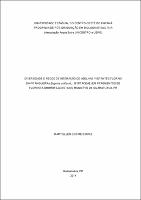| Compartilhamento |


|
Use este identificador para citar ou linkar para este item:
http://tede.unicentro.br:8080/jspui/handle/tede/413| Tipo do documento: | Dissertação |
| Título: | DIVERSIDADE E REDES DE INTERAÇÃO DE ABELHAS VISITANTES FLORAIS DA PITANGUEIRA (Eugenia uniflora L., MYRTACEAE) EM FRAGMENTOS DE FLORESTA OMBRÓFILA MISTA NO MUNICÍPIO DE GUARAPUAVA, PR |
| Título(s) alternativo(s): | não consta |
| Autor: | Diniz, Mary Ellen dos Reis  |
| Primeiro orientador: | Buschini, Maria Luisa Tunes |
| Primeiro coorientador: | Silva, Cláudia Inês da |
| Resumo: | Eugenia uniflora pertence à família Myrtaceae. Eugenia é o gênero mais diverso entre as Angiospermas do bioma Mata Atlântica, o qual possui várias formações florestais, entre elas a Floresta Ombrófila Mista, que atualmente encontrase fragmentada. A polinização em Myrtaceae ocorre principalmente pelas abelhas. A análise polínica permite o conhecimento da história de visitação das abelhas e é uma ferramenta de complemento no estudo das interações entre abelhas e flores. Estudos sobre redes de interação têm auxiliado a compreensão da dinâmica das relações mutualísticas. O objetivo deste trabalho foi investigar a diversidade de abelhas visitantes florais de E. uniflora e a relação das abelhas com suas flores. Este estudo foi realizado em duas áreas localizadas no município de Guarapuava, PR, Sul do Brasil. Foi calculada a diversidade de abelhas, índices de constância e dominância das espécies e correlação entre variáveis abióticas e atividade das abelhas. Todo o material polínico, proveniente do corpo das abelhas e das plantas encontradas nas proximidades foi submetido ao processo de acetólise. O período de floração ocorreu entre 25 de Agosto até 14 de Setembro de 2012. A antese de E. uniflora iniciou-se por volta das 5h 30min e as flores duraram um dia. Foram obtidas 826 abelhas, de 39 espécies e quatro famílias, sendo a família Halictidae a de maior riqueza (N= 23), seguida por Apidae (N=11), Colletidae (N=4) e Andrenidae (N=1). Apis mellifera foi a única espécie comum e a mais abundante (N= 337), seguida por Scaptotrigona bipunctata (N=293) e Melipona obscurior (N=74). Foram coletadas sete espécies classificadas como intermediárias e 31 espécies raras. Foi obtido um maior número de abelhas visitantes florais nos horários de 10h e 11h. Houve correlação entre a atividade das abelhas e as variáveis abióticas. Foram obtidas 29 espécies de abelha com carga polínica e 20 tipos polínicos. Todas as abelhas apresentaram hábitos generalistas e Eugenia uniflora foi a única que interagiu com todas as espécies de abelha. Apis mellifera foi a espécie mais generalista. As redes obtidas são aninhadas, com baixa especialização e há forte interação das abelhas com E. uniflora, o que revela que suas flores são uma importante fonte de pólen para as abelhas que a visitam. |
| Abstract: | Eugenia uniflora belongs to the Myrtaceae family. This genus is the most diverse among the Angiosperms the Atlantic Forest biome, which has several forest formations, including the Araucaria Moist Forest, which currently is fragmented. Pollination in Myrtaceae occurs primarily by bees. Pollen analysis allows knowledge of the history of visitation of bees and is a complementary tool in the study of interactions between bees and flowers. Studies about interaction networks have aided in understand of the dynamics of mutualistic relationships. The objective of this study was investigate the diversity of bee pollinators of E. uniflora and the relationship of bees with their flowers. This study was performed in two areas located in Guarapuava, PR, Southern Brazil. Diversity of bees, indices of consistency and dominance of species and abiotic variables and correlation between activity of bees were calculated. All the pollen material from the body of bees and plants found nearby was subjected to acetolysis process. The flowering period was from August 25?? until September 14th 2012. Anthesis of the E. uniflora starts around 5:30 a.m. and the flowers last one day. Were obtained 826 bees, of the 39 species and four families, with the highest family Halictidae richness (N= 23 ), followed by Apidae (N= 11), Colletidae (N= 4) and Andrenidae (N= 1). Apis mellifera was the only common and most abundant species (N= 337 ), followed by Scaptotrigona bipunctata (N= 293) and Melipona obscurior (N= 74). Seven species were classified as intermediate and 31 species were classified as rare. Was obtained a larger number of flower visiting bees in times at 10:00 a.m. and 11 a.m. There was a correlation between activity of bees and abiotic variables. Were obtained 29 species of bee with pollen load and 20 pollen types. All the bees present generalist habits and E. uniflora was the one who interacted with all species of bee. Apis mellifera was the most generalist specie. The networks obtained are nested, with low specialization and there is strong interaction of bees with E. uniflora, which reveals that your flowers are an important funding pollen for bees who visit. |
| Palavras-chave: | Riqueza Halictidae Apis mellifera Aninhamento Pólen Mata Atlântica Wealth Halictidae Apis mellifera Nesting Pollen Atlantic Forest |
| Área(s) do CNPq: | CIENCIAS BIOLOGICAS::BIOLOGIA GERAL |
| Idioma: | por |
| País: | BR |
| Instituição: | UNICENTRO - Universidade Estadual do Centro Oeste |
| Sigla da instituição: | UNICENTRO |
| Departamento: | Unicentro::Departamento de Biologia |
| Programa: | Programa de Pós-Graduação em Biologia Evolutiva (Mestrado) |
| Citação: | DINIZ, Mary Ellen dos Reis. não consta. 2014. 106 f. Dissertação (Mestrado em Biologia Evolutiva) - UNICENTRO - Universidade Estadual do Centro Oeste, Guarapuava, 2014. |
| Tipo de acesso: | Acesso Aberto |
| URI: | http://localhost:8080/tede/handle/tede/413 |
| Data de defesa: | 1-Jan-2014 |
| Aparece nas coleções: | Programa de Pós-Graduação em Biologia Evolutiva |
Arquivos associados a este item:
| Arquivo | Descrição | Tamanho | Formato | |
|---|---|---|---|---|
| PR MARY ELLEN DOS REIS DINIZ.pdf | 1,4 MB | Adobe PDF |  Baixar/Abrir Pré-Visualizar |
Os itens no repositório estão protegidos por copyright, com todos os direitos reservados, salvo quando é indicado o contrário.




